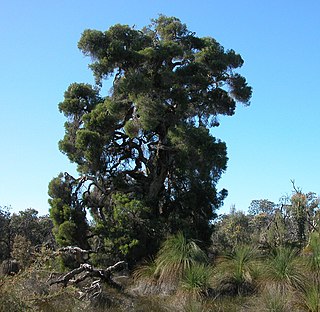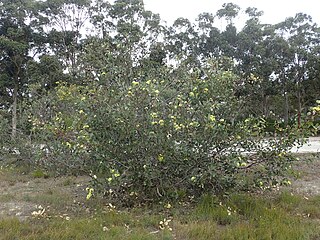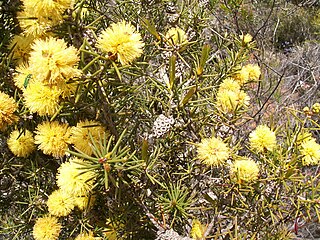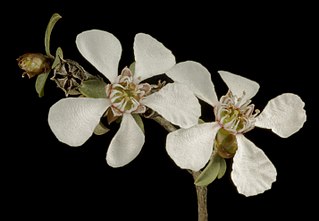
Melaleuca preissiana, commonly known as stout paperbark, modong or moonah, is a plant in the myrtle family, Myrtaceae and is endemic to coastal areas of southwest Australia. It is a shrub or small tree with papery bark, small leaves and spikes of usually white flowers. It occurs chiefly in areas that are seasonally wet.

Hypocalymma is a genus of evergreen shrubs in the myrtle family Myrtaceae described as a genus in 1840. The entire genus is endemic to southern Western Australia.

Eucalyptus preissiana, commonly known as bell-fruited mallee, is a species of small tree or shrub that occurs in an area between Albany and Esperance in Western Australia. It has a spreading habit, smooth bark, elliptical to egg-shaped or oblong leaves, flower buds in groups of three, yellow flowers and cup-shaped, conical or bell-shaped fruit.

Hypocalymma angustifolium, commonly known as white myrtle, or pink-flowered myrtle, is a species of flowering in the myrtle family Myrtaceae, and is endemic to the south west region of Western Australia. The Noongar peoples know the plant as koodgeed or kudjidi. It is an erect, multi-stemmed shrub with narrowly linear leaves, white or pale pink flowers.
Wurmbea monantha is a perennial herb that is native to Western Australia. The white to pink flowers are produced between July and September in its native range.

Thryptomene saxicola, commonly known as rock thryptomene, is a species of flowering plant in the family Myrtaceae and is endemic to the south-west of Western Australia. It is a spreading shrub with small oval or egg-shaped leaves and pale pink flowers arranged in leaf axils. It is hardy plant, common in cultivation, sometimes as "Payne's hybrid" or Thryptomene paynei.

Melaleuca pungens is a shrub in the myrtle family Myrtaceae which is endemic to the south-west of Western Australia. It is very prickly, with a large number of spherical, yellow flower heads.

Melaleuca aspalathoides is a small shrub in the myrtle family, Myrtaceae and is endemic to a small area in the south-west of Western Australia. It is a small shrub with soft, grey foliage and distinctive calyx lobes around each of its magenta-coloured flowers.

Melaleuca leptospermoides is a plant in the myrtle family, Myrtaceae and is endemic to a small area in the south-west of Western Australia. It is an erect shrub with narrow leaves, pinkish or purple flowers and small fruit, and is similar to Melaleuca tuberculata except that it lacks brown bracts at the base of the flowers.

Melaleuca holosericea is a plant in the myrtle family Myrtaceae which is endemic to the south-west of Western Australia. It is a small, rare shrub similar to other pink-flowered species in the Melaleuca scabra group.
Melaleuca manglesii is a plant in the myrtle family Myrtaceae and is endemic to a small area in the south-west of Western Australia. It is a low, spreading shrub which produces large numbers of heads of purple flowers with yellow tips in spring.
Verticordia lehmannii is a flowering plant in the myrtle family, Myrtaceae and is endemic to the south-west of Western Australia. It is slender shrub with only a few branches, well-spaced, oppositely arranged leaves and small heads of pale pink to silvery flowers with a dark pink centre.

Agonis theiformis is a species of flowering plant in the family Myrtaceae and is endemic to the southwest of Western Australia. It is a shrub with elliptic to egg-shaped, sometimes broadly egg-shaped leaves, and clusters of white flowers with mostly 15 to 20 stamens opposite the sepals, the fruit a spherical cluster of cup-shaped capsules.

Kunzea pauciflora, the Mount Melville kunzea, is a species of flowering plant in the myrtle family Myrtaceae, and is endemic to a small area on the south coast of Western Australia. It is a shrub with the stems densely branched near their ends, linear leaves and one, two or three pink flowers near the ends of the branches but usually only at the top of the shrub.

Calytrix asperula, commonly known as brush starflower, is a species of flowering plant in the myrtle family Myrtaceae and is endemic to the south of Western Australia. It is a mostly glabrous shrub with linear to narrowly elliptic leaves and cream-coloured to yellow flowers with 40 to 60 yellow stamens in several rows.

Hypocalymma asperum is a species of flowering in the myrtle family Myrtaceae, and is endemic to the south west region of Western Australia. It is an erect, multi-branched or spreading shrublet, with relatively short, stout leaves, and rose pink flowers.

Hypocalymma cordifolium is a species of flowering plant in the myrtle family Myrtaceae, and is endemic to the south west of Western Australia. It is usually an low-growing shrub, but is sometimes erect, with winged stems, heart-shaped leaves arranged in opposite pairs, white or pale pink flowers mostly arranged in pairs in leaf axils, and fruit containing pearly white or pale brown seeds.

Leptospermopsis erubescens, commonly known as the roadside tea tree, is a species of shrub that is endemic to southwest of Western Australia. It has thin, fibrous bark, egg-shaped leaves, small white flowers and woody fruit.
Rinzia schollerifolia, commonly known as the Cranberry rinzia, is a plant species of the family Myrtaceae endemic to Western Australia.
Plantae preissianae sive enumeratio plantarum quas in australasia occidentali et meridionali-occidentali annis 1838-1841 collegit Ludovicus Preiss, more commonly known as Plantae preissianae, is a book written by Johann Georg Christian Lehmann and Ludwig Preiss.















